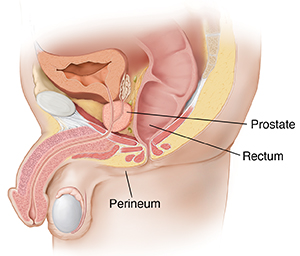Prostate Needle Biopsy
If your prostate-specific antigen (PSA) test, digital rectal exam (DRE), or other tests suggest you might have prostate cancer, a biopsy might be needed. Prostate needle biopsy is a test commonly used to check for prostate cancer. You may hear it called a core needle biopsy.
During this test, a thin, hollow needle is used to take small pieces of tissue (called samples) out of the prostate. The samples are then tested in a lab to see if there are cancer cells in them. This test is the main way to diagnose prostate cancer.
Getting ready for the procedure
Prepare as you have been told. Here are some things you can expect:
-
Tell your healthcare provider about all the medicines you take. This includes herbs, vitamins, CBD, and other supplements. Be sure to mention any blood thinners, including daily aspirin. You may need to stop taking some or all of them before the biopsy.
-
Ask if you can eat and drink the day of your biopsy.
-
You may be told to use a laxative, enemas, or both before the biopsy. This is to clean stool out of your colon and rectum. Follow the instructions you are given.
-
Your healthcare provider may have you start antibiotics before the biopsy. These help prevent infection. Be sure to take these as directed.
Risks and possible complications
Your provider will talk with you about possible risks before the biopsy is done. Complications are rare but include:
The day of the procedure
Prostate biopsy can be done in a healthcare provider’s office or a hospital. It takes about 45 minutes. You'll be able to go home the same day. But you'll need someone to drive you home.
Transrectal ultrasound (TRUS) is often used to do the biopsy. It uses sound waves to make images of your prostate on a computer screen. Sometimes, an MRI scan is used to "see" the prostate instead of or along with ultrasound. The images help the healthcare provider put the needle in the right place.
During the biopsy:
-
If ultrasound will be used, you may be asked to drink water to fill your bladder.
-
You'll put on a hospital gown and lie on your side on an exam table.
-
The ultrasound transducer, which is about the size of a finger, is lubricated. It's then put into your rectum. This will feel like a prostate exam. It won't hurt, but you'll feel pressure. The transducer is moved until the prostate can be seen on the screen.
-
Medicines called local anesthetics may be used to numb the biopsy area. You might also be given medicine to make you sleepy.
-
Using the images from the ultrasound and MRI (if done) as a guide, the biopsy tool (called a biopsy gun) is put against your prostate in 1 of these 2 ways:
-
It may be put in through your rectum, then the needle goes through the wall of your rectum and into your prostate. This is called a transrectal biopsy.
-
The biopsy gun can be put against the skin between your scrotum and anus (perineum). The needle then goes through your skin into your prostate. This is called a transperineal biopsy.
-
The needle is used to take tissue samples from the prostate. It moves in and out of your prostate very quickly. You might feel stinging or burning. You might hear the gun clicking as the needle moves. About 12 samples are taken from different parts of the prostate. These samples are sent to a lab to be tested.

After the biopsy
At first, you may feel a little lightheaded, especially if you had medicine to make you sleepy. You can stay on the table until you feel able to stand. You can go home once you're feeling better.
You can go back to your normal activities right away. But you might be sore and find it uncomfortable to sit for a few days. You may see some blood in your stool for a few days. This is normal. You may also notice blood in your urine and semen for a few weeks after the biopsy. This is also normal. Be sure to finish your antibiotics as directed. Your healthcare provider can tell you more about what to expect.
Follow-up care
It usually takes several days for the results of your biopsy to come back. When your healthcare provider has the results of your biopsy, they will contact you. Ask how you can expect to find out your biopsy results. Will it be a phone call or do you need to make an appointment?
Depending on the biopsy results, you may need more tests. If cancer is found, you and your healthcare provider will talk about what the next steps will be.
When to call your healthcare provider
Call your healthcare provider right away if you have any of these:
-
Blood clots in your urine
-
Bloody diarrhea
-
Blood in your urine or stool that doesn’t go away after 48 hours
-
Chest pain or trouble breathing (call 911)
-
Chills
-
Feeling weak
-
Fever of 100.4°F (38°C) or higher, or as directed by your healthcare provider
-
Can't pass urine
-
Pain that's getting worse